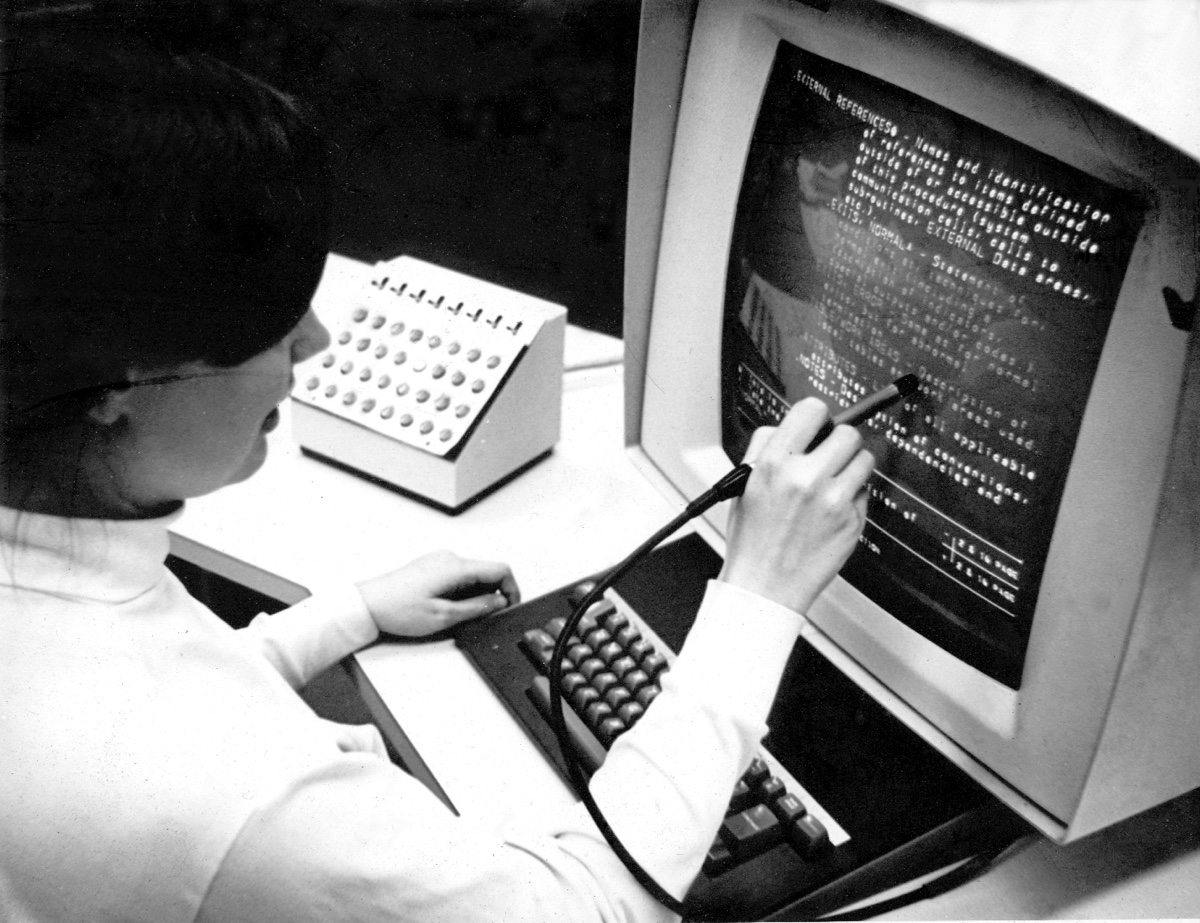The second hypertext system is HES (cf. 2.1.4), which stands for Hypertext Editing System. It was developed by Andries van Dam and Ted Nelson at Brown University in 1967 on an IBM/360 Model 50 mainframe within a 128K partition of memory. HES was actually used by NASA to write the documentation for the Apollo missions [van Dam 87].
After van Dam has witnessed the NLS presentation at FJCC he started the development of a new File Retrieval and Editing System. The design goal of FRESS (cf. 2.1.4) was to take the best from NLS and HES, and to overcome some limitations of the prior hypertext systems.
2.1.4 HES and FRESS
in Vision and Reality of Hypertext and Graphical User Interfaces
The first major conference on hypertext was ACM Hypertext ’87 in Chapel Hill, North Carolina. The keynote speaker was Andries van Dam, who created the Hypertext Editing System (HES) together with Ted Nelson twenty years before at Brown University. In his keynote address he refers to the system and describes its qualities, Hypertext ’87 Keynote Address [van Dam 87]. HES’ two main objectives are the online production of printed documents and the exploration of the hypertext concept. The first goal is met insofar as NASA used the system successfully to produce the user manuals for the Apollo mission to Moon. Invisible control information allows the printing of the entire hypertext in linear form.
The second goal is strongly influenced by Ted Nelson. HES and Xanadu share the same approach in memory management. Instead of directly editing raw text, edits are done by pointer manipulation to text fragments. This architecture promotes the distinction between inclusion and reference in HES. Inclusion, respectively Ted Nelson’s term transclusion, uses instances of text in several places. If one instance of text is modified the changed text will show up in all other places as well. Van Dam comments nonchalantly, «Instances are a standard idea from computer graphics – no big deal.» [van Dam 87, p. 889]. This “standard idea” was invented by Ivan Sutherland in the early 1960s and will be presented in 3.1.2 Sketchpad (p. 54).
After attending Doug Engelbart’s legendary NLS demo in 1968, Andries van Dam and his team start all over. Their second hypertext system FRESS – the File Retrieval and Editing System – builds on their experience with HES and incorporates also concepts from NLS. FRESS does outline processing like NLS, but is less rigid. In particular, no limitation in statement size restrains the user. For that reason the system allows «a more freeform editing style» [Ibid., p. 890]. FRESS is also more responsive than its predecessors. The speed is about the same whether the user is working on a 2-page or on a 200-page document.
The link handling is also improved in FRESS. For the first time bi-directional links are implemented. They are called jumps. Uni-directional links are called tags and have a special purpose. Nicole Yankelovich explains the difference in Reading and Writing the Electronic Book [Yankelovich et al. 85, p. 23]:
A tag–a one-way link–indicated a connection to a single element such as an annotation, definition, or footnote. When a reader pointed to a tag […], the associated text appeared in another window […] for reference while the reader remained in the main document. Unlike a tag, a jump–a bidirectional link–indicated a path to another document. By following a jump, the reader was transferred from one document to another […]. Since cross-reference markers (destinations of links) were displayed in the text, readers could backtrack through a sequence of links […].
Links are not stored within the documents. In a collaborative environment the external link database can be used to show or hide the links that have been defined by other users. Hyperlinks are also typed. That means that they can be labelled with keywords. Links with the same label form a path that can be followed like Memex’ trails.
There was no mouse at the IBM/360. A light pen was used instead to point on hyperlinks. James Gillies and Robert Cailliau write, «It was more like point-and-kick than point-and-click: you would point with the light pen and click with a foot pedal.» [Gillies/Cailliau 2000, p. 104].
FRESS provides also annotation capabilities. Van Dam recalls that this lead to the first «electronic graffiti» in an English poetry course where FRESS was used in the early 1970s [van Dam 87, p. 891].
Update 12/2018

HES on an IBM 2250 Mod 4 display station, including lightpen and programmed function keyboard, channel coupled to Brown's IBM 360 mainframe. /CCBY2.0 Greg Lloyd 1969 via Wikipedia
![]() For a free PDF version of Vision and Reality of Hypertext and Graphical User Interfaces (122 pages), send an e-mail to:
For a free PDF version of Vision and Reality of Hypertext and Graphical User Interfaces (122 pages), send an e-mail to:
![]() mprove@acm.org I’ll usually respond within a day. [privacy policy]
mprove@acm.org I’ll usually respond within a day. [privacy policy]
à propos
- Belinda Barnet: Hypertext before the Web – or, What the Web Could Have Been In: Niels Brügger, Ian Milligan (eds): The SAGE Handbook of Web History